The Mise-en-scene is a French term which means “put in the scene” or “aspects of the scene”. In Film, its meaning is vast including composition and framing, sets, props, acting and lighting. In cinema, anything which is incorporated into the shot and the arrangement of it has been produced for a reason, to create representations and to allow the audience to generate ideas on the action on screen automatically, without being introduced to the narrative.
In our film, Mise-en-scene will be crucial in order to create an atmosphere as well as produce particular representations of subjects.
Mise-en-scene in cinema comprises of these ingredients;
Production purposes: Sets, costumes and Props.
The use of colour: Tones, strength and both in production and post-production.
The use of Lighting
The performance of the Actors: facial expression, use of props and body language.
Mise-en-scene and the viewer:
As the audience, a movie relies on the mise-en-scene to produce special effects, no other aspect of film production can create. Films which incorporate mise-en-scene well allow the view to stop and analyse the composition and framing of the scene, and what it tells us as a viewer. The narrative can be articulated by the mise-en-scene, as movements of actors or composition of sets can alter the power relationships and atmosphere of scene instantly.
Mise-En-Scene in Psycho
As part of my research, I studied the film “Psycho”, by Alfred Hitchcock. The film is a perfect example of the incorporation of all elements of cinema, especially mise-en-scene. I decided to study Hitchcock use of mise-en scene to indentify prefect examples of its use, which I could integrate into the film opening.
Lighting and Sets
Lighting is a crucial aspect of Psycho, especially during the scene in the parlour.
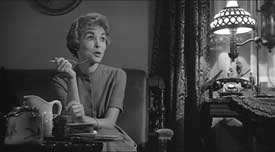
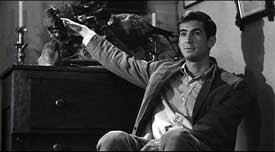
The Parlour Set
The room is depicted a tiny, only sufficient to fit in a lamp, a coffee table, two chairs, a chest, curtains, pictures, candles, several other small items and a lamp. The lamp is located toward the left of Marion, and it the only light portrayed in the scene. As the light was the only source it produced certain effects on each character, which demonstrate the certain aspects of their constructs.
As Marion is sat close to the lamp, her face appears perfectly lit and it highlights her beautiful features and produces an angelic, glimmering effect. However, the light makes her stand out, making her somewhat vulnerable, almost like a “rabbit in the headlights”. However, the light could indicate that Marion’s bad deed of embezzlement is not an act of evil, as she is not hidden by the shadows which demonstrations of the connotations of her innocent character. Moreover the soft effect the high key lighting makes her appear soft and delicate, furthermore making her stand out from the dull and grim background of the motel. No shadows of Marion are indicated, telling the audience she is pure and genuine.
However the composition of Norman is extremely clever. Norman is placed away from the source of light and slightly to the edge. This effect produces stark contrast, producing a shadow of Norman as well as additionally hiding half of Norman in darkness, demonstrating the psychological state of the character with the schizophrenia aspect of his character. Additionally the low key lighting portrays the consumption of his character by evil, the stark contrasts in shadow demonstrate how an element of his persona is hidden while the shadows which threateningly fill the room portray the hidden side of Normans mind which wish to emerge, how they are omnipresent in Norman, waiting to strike.
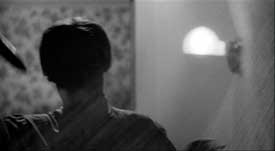
In the shower Scene, the killer is completely consumed by shadow, firstly to hide the identity of the killer and the figures outline trick the audience into believing the mother is the killer. Additionally the shadow indicates how the mother side of Norman’s persona has completely consumed Norman, allowing him to commit the gruesome murders.
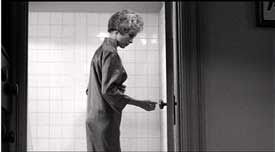
In this shot, Marion is portrayed walking into the high key lighting. She appears vulnerable in her near nudity and the high key lighting is symbolic of Marion taking the steps to heaven, indicating he immediate death and portraying her innocence, despite her crimes.
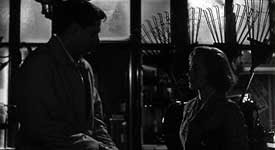
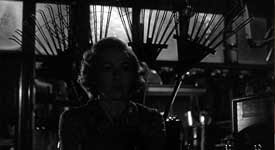
The Shots above are very interesting. Shot is composed of the female and male subjects, several small bright windows which create the shadow effects, as well as the eerie and dominant three rakes. The three rakes, although connotations of their domestic usage also have connotations of weapons and a knife. The fatal use of this domestic item parallels the use of a kitchen knife in Marion’s murder, making the props significant.
The female subject is eclipsed in shadow, portraying the dangerous investigation she is producing while the rakes behind her exemplify the immediate death which she is finding, the height of rakes make the female subject appear more vulnerable.
No comments:
Post a Comment